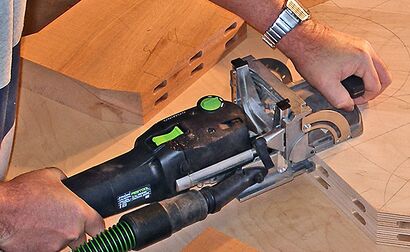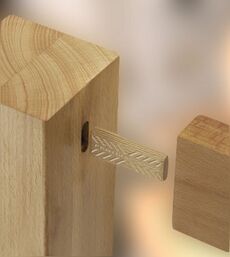The Domino is a loose mortise and tenon joining tool manufactured by the German company Festool.
History and description
First introduced in 2005, it came to the US market in 2007.[1]
The core idea for this type of a tool came from German master cabinetmaker Vitus Rommel.[2][3] It envisioned a tool that can cut a mortise in single operation - putting it on par with a biscuit joiner on speed while allowing for a more flexible and potentially stronger floating-tenon joint.
The tool implementation by Festool involves a router-like spinning shaft with a special shape cutter bit. The shaft also moves sideways, allowing to cut full round-ended mortises in a single operation.[1] Each plunge creates a mortise that is sized to accept a standard 'DOMINO' loose tenon with an oval-shaped cross section.
The original tool supported cutter sizes from 4 mm to 10 mm with available tenon sizes from 4x20 mm up to 10x50 mm. This allowed joints in stock as thin as 10 millimetres (0.39 in). Later a bigger tool was introduced allowing tenon sizes up to 14x140 mm, opening many carpentry use cases for the tool family.
The tool series was envisioned from the beginning for high workflow efficiency, namely:
- - single-operation workflow
- - referencing pins (or flaps, depending on model) for precise operation without marking
- - adjustable mortise width, reducing secondary mortises placement requirements
- (works with narrow "positioning" of the first mortise for placement while secondary mortises are placed 'loosely' for strength)
- - fence natively supports tilting between 0° and 90° with stops at common angles
- - the plunge depth, mortise width, tilt angle and referencing pins/flaps are all adjustable without tools and without any need to adjust the cutter
- - standardized cutters with exact dimensions avoid the need of precise cutter positioning in the collet
The compactness of a hand-operated tool coupled with the focus on workflow efficiency is what allows the DOMINO mortising tools to service most use cases serve by the simpler tools for 'biscuit' and dowel joints expanding loose-tenon use cases significantly.
In smaller businesses or with the DIY users, where industrial machinery is not available, a cabinetmaker may employ a DOMINO loose-tenon joint where other, less complicated but more laborious, joints would have to be employed otherwise.
Advantages
- Allows very quick joinery, useful in a commercial carpentry setting.
- Flat tenons resists torquing.
- Stronger than a biscuit joiner.
Disadvantages
- High tool cost comparative to other joinery methods
- Proprietary tenons (dowels) required
- Noise, similar to biscuit joiners
- The originals series of tools cannot operate without external dust extraction
See also
- Biscuit joiner — general page on biscuit joinery methods
- Dowelmax — another loose tenon joinery system
- Dowels - general page on dowels
References
- ↑ 1.0 1.1 Lua error in Module:Citation/CS1/Configuration at line 2123: attempt to index field '?' (a nil value).
- ↑ Lua error in Module:Citation/CS1/Configuration at line 2123: attempt to index field '?' (a nil value).
- ↑ Lua error in Module:Citation/CS1/Configuration at line 2123: attempt to index field '?' (a nil value).
External links
- www.festool.net — Manufacturer's official international website
- festoolusa.com — the Domino page at the Festool USA site

